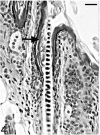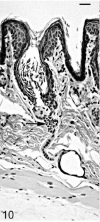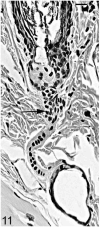Molecular basis for hair loss in mice carrying a novel nonsense mutation (Hrrh-R ) in the hairless gene (Hr)
- PMID: 20080498
- PMCID: PMC2865226
- DOI: 10.1177/0300985809352970
Molecular basis for hair loss in mice carrying a novel nonsense mutation (Hrrh-R ) in the hairless gene (Hr)
Abstract
Animal models carrying mutations in the hairless (Hr) gene provide a rich resource for study of hair follicle biology. A spontaneous mouse mutant with a phenotype strikingly similar to rhino mutants of Hr arose spontaneously in the mouse facility at Oak Ridge National Laboratory. Sequence analysis of Hr in these mutants uncovered a nonsense mutation in exon 12, designated as Hr(rh-R) (rhino, Oak Ridge). The mutation led to significant reduction in Hr mRNA levels, predicted to be due to nonsense-mediated decay. Histological analysis indicated dilated hair follicle infundibula at 14 days of age that rapidly became filled with cornified material. Microarray analyses revealed that expression levels of many genes involved in keratinocyte differentiation, epidermal regeneration, and wound healing were significantly upregulated before morphological detection of the phenotype, suggesting their role in onset of the Hr(rh-R) phenotype. Identification of this new Hr allele and the underlying molecular alterations allows further understanding of the role of Hr in hair follicle biology.
Figures















Similar articles
-
Molecular basis for the rhino (hrrh-8J) phenotype: a nonsense mutation in the mouse hairless gene.Genomics. 1998 Nov 1;53(3):383-6. doi: 10.1006/geno.1998.5495. Genomics. 1998. PMID: 9799606
-
A new allele of the mouse hairless gene interferes with Hox/LacZ transgene regulation in hair follicle primordia.Exp Mol Pathol. 2004 Apr;76(2):173-81. doi: 10.1016/j.yexmp.2003.10.003. Exp Mol Pathol. 2004. PMID: 15010296
-
Molecular basis of a novel rhino (hr(rhChr)) phenotype: a nonsense mutation in the mouse hairless gene.Exp Dermatol. 1998 Oct;7(5):298-301. doi: 10.1111/j.1600-0625.1998.tb00300.x-i1. Exp Dermatol. 1998. PMID: 9832318
-
Molecular and functional aspects of the hairless (hr) gene in laboratory rodents and humans.Exp Dermatol. 1998 Oct;7(5):249-67. doi: 10.1111/j.1600-0625.1998.tb00295.x-i1. Exp Dermatol. 1998. PMID: 9832313 Review.
-
[The mouse hairless gene: its function in hair root and at the heart of a subtle pleiotropy].Med Sci (Paris). 2006 May;22(5):525-30. doi: 10.1051/medsci/2006225525. Med Sci (Paris). 2006. PMID: 16687122 Review. French.
Cited by
-
Simple generation of hairless mice for in vivo imaging.Exp Anim. 2017 Oct 30;66(4):437-445. doi: 10.1538/expanim.17-0049. Epub 2017 Jul 18. Exp Anim. 2017. PMID: 28717054 Free PMC article.
-
Novel rhino-like SHJH hr mice with thyroid dysfunction.Zool Res. 2021 Nov 18;42(6):734-738. doi: 10.24272/j.issn.2095-8137.2021.211. Zool Res. 2021. PMID: 34636192 Free PMC article. No abstract available.
-
Hairless-knockout piglets generated using the clustered regularly interspaced short palindromic repeat/CRISPR-associated-9 exhibit abnormalities in the skin and thymus.Exp Anim. 2019 Nov 6;68(4):519-529. doi: 10.1538/expanim.19-0018. Epub 2019 Jul 15. Exp Anim. 2019. PMID: 31308290 Free PMC article.
-
Gene expression profile of the skin in the 'hairpoor' (HrHp) mice by microarray analysis.BMC Genomics. 2010 Nov 18;11:640. doi: 10.1186/1471-2164-11-640. BMC Genomics. 2010. PMID: 21083932 Free PMC article.
-
Transgenic mice display hair loss and regrowth overexpressing mutant Hr gene.Exp Anim. 2017 Oct 30;66(4):379-386. doi: 10.1538/expanim.16-0115. Epub 2017 Jul 5. Exp Anim. 2017. PMID: 28679963 Free PMC article.
References
-
- Ahmad W, Haque MF, Brancolini V, Tsou HC, Haque S, Lam HM, Aita VM, Owen J, deBlaquiere M, Frank J, Cserhalmi-Friedman PB, Leask A, McGrath JA, Peacocke M, Ahmad M, Ott J, Christiano AM. Alopecia universalis associated with a mutation in the human hairless gene. Science. 1998;279:720–724. - PubMed
-
- Ahmad W, Nomura K, McGrath JA, Hashimoto I, Christiano AM. A homozygous nonsense mutation in the zinc-finger domain of the human hairless gene underlies congenital atrichia. J Invest Dermatol. 1999;113:281–283. - PubMed
-
- Ahmad W, Panteleyev AA, Henson-Apollonio V, Sundberg JP, Christiano AM. Molecular basis of a novel rhino (hrrhChr) pheno-type: a nonsense mutation in the mouse hairless gene. Exp Dermatol. 1998;7:298–301. - PubMed
-
- Ahmad W, Panteleyev AA, Sundberg JP, Christiano AM. Molecular basis for the rhino (hrrh-8J) phenotype: a nonsense mutation in the mouse hairless gene. Genomics. 1998;53:383–386. - PubMed
-
- Ahmad W, Ratterree MS, Panteleyev AA, Aita VM, Sundberg JP, Christiano AM. Atrichia with papular lesions resulting from mutations in the rhesus macaque (Macaca mulatta) hairless gene. Lab Anim. 2002;36:61–67. - PubMed
Publication types
MeSH terms
Substances
Grants and funding
LinkOut - more resources
Full Text Sources
Molecular Biology Databases

